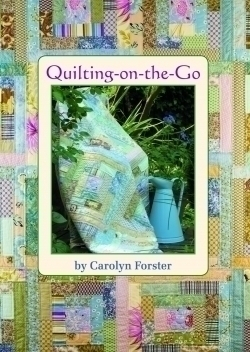Quilting on the Go
From a perspective of size alone, a lone quilter can find the basic acts of putting together a large quilt top, batting, and backing sandwiches a daunting task. Add to the assembly the tasks of basting, and then quilting, full- or queen- or king-sized quilts and it’s easy to see how too many end up tossed into bins with other unfinished projects. In her new book, Forster resurrects a popular alternative to handling large, cumbersome quilts.
At first glance, Quilting-on-the-Go reminds readers of Georgia Bonesteel and her lap quilting techniques, made popular in the 1970s, 80s, and 90s. The lap quilting or, as Forster refers to it, ‘Quilting-on-the-Go,’ offers a method for piecing and quilting one square at a time. Note that quilting-ON-the-go is not the same as ‘quilting-AS-you-go’ techniques.
The lap quilt and quilt-on-the-go concepts are decidedly the same. Hand or machine piece a twelve-and-a-half-inch square, frame each square with strips of fabric, add a similar sized piece of batting and backing, hand or machine quilt the fabric sandwich together and move on to the next square. Smaller-sized squares, the author points out, are easy to tote and less intimidating. “Now you can sew quilts that have been created in small portable pieces, it means that tacking/basting is a small and manageable task.”
Forster fills the first half of her 120-page book with clear and helpful basic information. From choosing fabrics, tools, and notions, she proceeds to the step-by-step construction of an ‘On-the-Go’ quilt. She updates the Bonesteel techniques with pieced fabric frames that step away from the traditional framed squares and gives an all-over design to the quilt top such as Irish Chain or Broken Dishes. The second half of the book offers fifteen full-sized quilt projects based on familiar traditional patterns. Sadly the author does not introduce any new or original patterns, nor does she offer small projects such as totes or table runners.
According to her biography, this British native has been “making quilts for 22 years and teaching for the last 12.” This, her first book, features four-color photos, useful graphs, and a welcoming, easy-to-follow layout. First published in the UK in 2007, this low-tech book offers printed templates rather than a DVD. U.S. readers may encounter some unfamiliar wording – wadding rather than batting, for example.
Because the original Bonesteel books were written in the 1990s and before, and because most are out of print, Forster’s book fills a void in a beginning quilter’s library.
Reviewed by
Dawn Goldsmith
Disclosure: This article is not an endorsement, but a review. The publisher of this book provided free copies of the book and paid a small fee to have their book reviewed by a professional reviewer. Foreword Reviews and Clarion Reviews make no guarantee that the publisher will receive a positive review. Foreword Magazine, Inc. is disclosing this in accordance with the Federal Trade Commission’s 16 CFR, Part 255.

